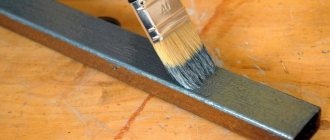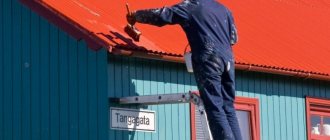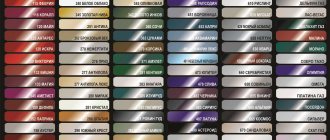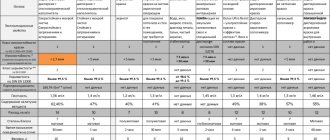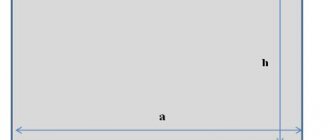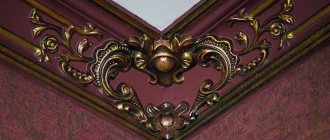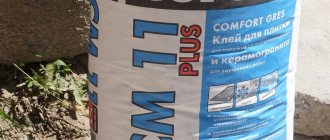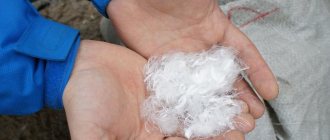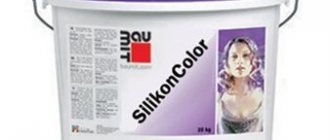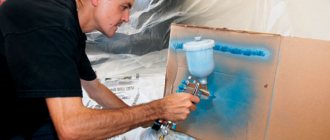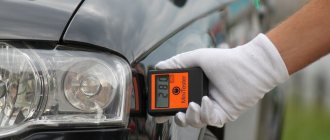Painting a car is a complex and time-consuming job that requires a lot of knowledge and skills. Masters of their craft who paint cars take into account even small details, since this business requires jewelry work. Amateurs think that painting a car is simple, not knowing what is behind it. In fact, only highly qualified specialists can turn your car into a diamond using their skills and knowledge.
Properties of acrylic paints and their advantages
You can protect the surface to be painted with acrylic paint due to the fact that the solvent dries almost immediately after its application.
This promotes the formation of a plastic film, which has increased elasticity and elasticity. This is why acrylic compositions are preferable when painting a vehicle body. A special feature of acrylic paint is also its resistance to water and temperature changes. Under the influence of cold air, the coating will not crack and will not begin to peel off some time after painting.
Painting a car with acrylic is a very simple task; you can apply the next layer almost immediately after the first (only 3-4 hours are enough to dry). This composition can be easily washed off from all used tools if it has not yet dried.
A distinctive feature of this paint is its durability. The service life can be up to 20 years if the purchased composition was of high quality. After complete drying, the painted surface can be cleaned and washed.
Regardless of the type of its composition, all acrylic paints have identical properties. This is due to the fact that the mixture is produced using a special technology and only high-quality components are used for this. Acrylic paint for cars has the following features:
- Service life is about 20 years.
- No cracks appear on the surface during operation, and the paint does not begin to peel.
- The composition is very resistant to impacts and atmospheric influences.
- Just a day after painting, the surface is already suitable for use.
- Even under the influence of chemicals and detergent mixtures, the paint does not lose its properties.
- To apply paint, you can use a spray gun, a regular brush or roller.
- The acrylic film that forms after painting is very durable, so there is no need to further secure it.
Composition and technical characteristics of automotive enamel
Automotive enamel consists of some elements:
- binder;
- pigment;
- solvent.
A binder is a necessary element in paint that holds and preserves the applied coating for many years. If we talk about pigment, its main function is to impart color and tone. The third element, a solvent, has the ability to dissolve paint, which makes it possible to apply it evenly to the surface. Automotive enamel is very popular. Repair enamel with a brush is used in cases of spot application where there are tears in the old paint or serious scratches.
Consumption per 1 m2
There are average indicators for the distribution of auto enamel per 1 m² - a quarter of a liter. To completely paint a car, approximately 2.5 - 3 liters of enamel are spent.
Paint consumption
The consumption of the coloring composition will depend on many factors, but basic information about consumption can be gleaned from the manufacturer's instructions.
Orange acrylic paint
You need to understand that the data will be reliable only if you apply paint in a layer of minimal thickness (it is best to do this using a spray gun), the surface is perfectly prepared and has an average ability to absorb paint.
This indicator will greatly depend on the method by which the paint is applied to the surface. A large amount of paint will have to be spent if a brush is used for the work. And the most economical device with which you can perform the work is a spray gun.
For coloring, you need to use only high-quality coloring compounds, which are an order of magnitude more expensive than others, but at the same time have good hiding power. Just two layers will be enough to get the desired shade.
Therefore, it is not paradoxical, but expensive paint in this case will cost much less than a larger amount of inexpensive acrylic composition. To work with acrylic paint, you will need to purchase a special tray, roller and putty.
Factors that determine paint consumption per car
Painting at a service will entail considerable expenses; it is cheaper to do it yourself. But when choosing the latter option, you need to have certain skills and calculate the paint consumption for the car. The quantity is influenced by several factors:
- original body color and new enamel
- car dimensions
- tools
- area to be painted (entire or separate area)
- paint viscosity
- personal experience in coloring
- surface preparation
Next, we will analyze all these factors in more detail.
Machine size
It is quite difficult to accurately determine how much paint is needed to paint a car. Below is the approximate paint consumption for individual parts.
| Detail | Consumption in ml/l |
| Door | 200 |
| Wing | 150 |
| Trunk | From 300 to 400 |
| Roof | 400 |
| Bumper | 300 |
| Back panel | 250 |
| Radiator grille | 100 |
| Threshold | 150 |
On average, to paint a car , you will need from 2 to 3 liters of enamel. A small minibus or Gazelle will require no more than 5 liters, for jeeps, vans, crossovers, business class cars - 4 -5 liters, segment comfort - about 3.5 liters.
Paint color and original body color
The consumption of paint and varnish material will depend on the original color of the car. If the color is contrasting with the original, more paint will be used than with standard coloring.
You need to know: dark colors do not overlap well with light shades.
It is necessary to apply paintwork in several layers. For example, red or yellow do not cover the substrate well. It may take about 9 or 10 coats of paint to completely cover. Black, green and their shades cover the base well.
Paint viscosity
Of all the parameters when painting a car, the most significant is the viscosity of the paintwork material. It depends on how correctly the coloring composition was diluted. Most cans indicate the proportions that must be followed when mixing the activator and paint. It could be 2:1 (or another value). In this case, dilute 2 parts of the dye and 1 part of the activator.
It is strictly forbidden to add all the ingredients by eye. Such an experiment can lead to the paint being either too thick or thin. In the first case, when painting, an “orange peel” effect occurs, and in the second, drips form.
A viscometer and a graduated container will help you calculate the required number of components. The operating principle of this device is to pour a certain amount of liquid into a special container through a hole of a certain diameter. The device's stopwatch records the time.
If you don’t have a professional measuring tool, you can use a regular ruler. It is placed in a container and a coloring agent is poured. The ruler scale determines the amount of activator that needs to be added.
Important: Viscosity may depend on the room temperature, as well as the surface of the parts. When the temperature in the garage is cold, “tears” form on the painted surface. It is better to perform coloring at a temperature not lower than +23C.
It is worth considering that the thicker the paint, the better its coverage, as a rule. This means that fewer layers will need to be applied than when using a less viscous material.
Type of spray gun, tools
Not only the quality of the painting itself, but also the consumption of paint and varnish material depends on the spray gun. You can find many different models of spray guns on sale. They all have different spray systems. The paint consumption is affected by the diameter of the nozzle and the uniformity of air supply by the compressor. Before applying enamel to the surface of the car, it is recommended to test the spray bottle on the inner surface of the part, and if everything is satisfactory, start painting the car.
Experience in car painting
Having skills will help reduce the consumption of paints and varnishes. There are a number of rules that should be followed when painting a car, otherwise the enamel layer will lie unevenly and you will have to additionally cover it. This may entail additional material costs. Therefore, if you have no experience in painting, then you should practice on some unnecessary surface.
The main nuances in coloring:
- Hold the spray gun correctly - the tool is held at a right angle relative to the surface of the part to be painted. It is permissible to hold it at an angle only when painting hard-to-reach places, arches, and ends;
- Monitor the distance between the spray gun and the surface to be painted - the distance should not be less than 15 cm and more than 20 cm. If you apply paint from a close distance, smudges will form, if too far away, this is fraught with excessive pollination and high paint consumption;
- Speed of hand movements - the higher the speed of movement of the spray gun over the surface, the thinner the layer obtained. But, this parameter can be adjusted by making the supply of varnish less or more;
- The trajectory of the tool - you need to move the spray gun from right to left. At the same time, it is important to maintain the same pace of movement.
Temperature and weather conditions
This parameter, as already noted, affects the viscosity of the coating material. It is also important for drying paintwork materials. There are paints that dry already at a temperature of +20. And, there is a material that requires high temperature to dry. Such enamels are used in workshops where there are all appropriate conditions.
Important: to save paint, it is advisable to apply a new layer after the previous one has dried
Preparing the surface to be painted
It is worth noting that the consumption of paint and varnish material is influenced by the correct preparation of the machine or its individual parts. The surface of the part must be finely porous and carefully polished. The optimal abrasive for matting the surface is sandpaper with a grit of P 800-P1200. Smaller grains impair the adhesion of paint and parts, while larger grains increase paint consumption.
Types of paint, auxiliary materials
The cost of materials when painting is influenced by their quality and individual characteristics. Most often, car owners prefer alkyd or acrylic enamels when painting them themselves. These materials lay down evenly and have good hiding power.
It is worth noting that the consumption of alkyd enamel is always greater than the consumption of acrylic enamel by approximately 40 percent. Take this nuance into account if you are guided by the average paint consumption indicators indicated in this article. They are more consistent with the consumption of acrylic paint.
Purchasing all related materials of the same brand as the paint (primer, varnish, paint thinner, etc.) will help reduce consumption. Because Manufacturers have already taken care of optimal adhesion and interaction of all materials when painting. And this, as you know, saves their volumes.
Composition of acrylic paints
Acrylic paint for cars is a synthetic composition that is made on the basis of a special polymer. It is this that acts as a connecting substance between water and the coloring pigment of the composition.
In order for the coloring composition to obtain all its properties, not crack and lose its appearance, additional components are needed; one binder will not be enough.
Therefore, manufacturers select the optimal amount of pigment (which gives the desired color) and filler (its use ensures good adhesion of the paint to the surface being painted and the paint goes on more evenly).
How to calculate the consumption of paint and varnish?
To calculate how much paint or varnish is needed to paint a car or its parts, you can use the average rate. According to approximate calculations per 1 sq.m. body, ¼ liter is spent. material. It follows from this that a vehicle will need 3.5 - 4 liters of paintwork.
As for the varnish, its consumption will be the same as the coloring composition (for a two-layer coating, the amount of substance must be multiplied by two). The amount of varnish also depends on the covering power of their base. Taking this parameter into account, in order to save on consumption, it is better to choose compounds made from synthetic resins. Nitro-combined and acrylic analogues “cover” the paint worse.
Car enamels from the manufacturer Vika
Quite often, car owners are faced with the problem of updating their car’s paintwork; this is caused by the negative influence of the external environment on the car’s coating. Automotive enamels are used to perform painting work.
The Vika brand represents a wide range of materials for the repair and restoration of bodywork. The Vika line of paints and varnishes contains acrylic and alkyd enamels used for painting vehicles. Not long ago, the company launched a new generation of material on the market - 2K acrylic-urethane enamel AK-1305. This vika enamel is produced in fourteen colors. Its difference from its predecessors lies in its increased viscosity and the time required for drying. In addition, the new generation of coatings is distinguished by gloss. Its presence eliminates the need to apply additional varnish.
The Vika brand represents a wide range of materials for the repair and restoration of bodywork.
Technical characteristics and scope
Vika auto enamel, sold at a very reasonable price, has the following parameters:
- Drying and processing modes;
- After painting is completed, the paintwork dries in 30 minutes. with uniform heating to 80 degrees, in 45 minutes. - at 60 degrees. and in 60 hours. at 20 degrees;
- Polishing the painted surface can only be done after 24 hours; the outside temperature should be in the range of 20 degrees.
Between applying different layers of paint and varnish, a pause of about 5-7 minutes is required.
Polishing the painted surface can only be done after 24 hours.
Advantages and disadvantages
Acrylic is quite often used to paint cars. In principle, this is a completely acceptable alternative to any other materials. This is partly due to the fact that acrylic-based enamels have a long service life, do not change appearance over time and do not require special care. The brand is represented by the vika color palette and this certainly pleases the buyer, because you can choose almost any tone.
Vetch enamel has a number of undoubted advantages:
- During painting, the vetch paint lays down smoothly, there are no drips and there are no conditions for the formation of such a defect as shagreen;
- The color strictly corresponds to the catalog number. This ensures that the color selection will be carried out perfectly and will match the tone of the car;
- Enamels are used either for complete or selective painting of body parts in any situation.
During painting, the vetch paint lays down smoothly and there are no drips.
How to dilute Vika paints
One of the significant components in painting work is solvent. There are a great variety of them, but only some of them can be used to properly dissolve paint. Let's look at the main types of this substance
In order not to make a mistake when choosing a solvent for acrylic or alkyd paint, you need to know and understand what solvents exist and how they are used. You need to understand that a thinner and a solvent are the same chemical substance. In addition, the manufacturer always indicates for which paint a particular solvent is acceptable. Of course, it is better to use a branded solvent; as a rule, the label placed on the paint container indicates the type of solvent suitable for this paint or primer.
Some car enthusiasts, out of habit, use organic solvents such as m pr. 646, 647, but this is not the best solution. When using organics to work with acrylic, certain difficulties may arise when painting, and therefore craftsmen advise using organic solvents to wash the devices used for painting.
If the branded solvent has run out, then it is permissible to use multi-purpose solvent P12. it was used to work with all acrylic-based paints and more.
If the branded solvent has run out, then it is permissible to use multi-purpose solvent P12.
Effects created by auto enamel
In order to paint a car you need a base car enamel. Each type of classification has special effects that are reflected on the body.
Glossy
Glossy surface is available on almost all car enamels. Alkyd paints are just not capable of creating a glossy effect. The gloss is formed due to the rapid polymerization that occurs when drying.
Matte
Applying enamels to cars without shine is called a matte effect. For a car, this type is not used on the entire body, but only to highlight a particular area. The best enamel with a matte effect is alkyd.
Nacre
The pearlescent effect is achieved by absorbing sunlight during the day. Thanks to this, the car shines and attracts special attention with its appearance.
Metallic
Metallic is achieved in the form of enamel, which has a reflective pigment. This car painting is difficult to achieve due to the need to mix it with pigments. Therefore, this matter must be trusted to professionals who know their business. You can achieve this effect even if the surface of a part of the car is matte.
Chameleon
This effect is very popular among car enthusiasts. It is achieved with three-layer painting, only thanks to “chameleon” enamel. If you look at the car from different angles, it seems that it is painted in different colors.
Chirallic
This effect is called artificial pearlescent. To do this, you need to paint it with the appropriate auto enamel, which will ensure long exposure. Can only be applied to a surface that is free of dirt and rust. The basic colors used for painting are red and blue. These are the 2 most elegant and beautiful colors in this model.
Sandy effect
Kandy coating is the most difficult job for a professional. Difficulty in work is replaced by incredible beauty and efficiency. The color and tone of the car will fascinate and catch your eye. There are approximately 20 types of colors. The only disadvantage of this type is that the staining layer is too small.
Phosphor
Duminofor is a chemical substance that is resistant to external influences. In addition to the fact that it protects the car from corrosion, the paint will last for 20 years or more. This paint has a luminous effect and can glow in the dark.
Important. The effects of various auto enamels depend on the method of application and the chemical composition of the enamel itself. To achieve the desired effect, you need to know how to use the paint, in what proportions to apply it, and adhere to a certain intensity.
Tips for choosing
The composition of car paint always includes additional components, fillers, solvents, fixatives and additives, the addition of which significantly changes the chemical composition and physical properties of the paintwork. You should definitely show maximum attention to them.
In addition, be sure to study the technical specifications declared by the manufacturer:
- viscosity;
- drying speed;
- best before date;
- compatibility with varnish and chemicals;
- overlap;
- temperature and characteristics of the drying process;
- color palette and color accuracy.
It is important to understand that some manufacturers produce paint in colors that are designed for a certain model range of cars and do not always suit your car. Usually this information is also indicated on the packaging.
The cost of the can, the mixing mechanism, the difficulty of applying paint to car body parts, the environmental friendliness of the composition and the requirements for painting conditions are also important. If the paint is toxic or requires a difficult microclimate in the paint booth area, it may make sense to choose a different paint coating.
In conclusion, it should be noted that choosing paint enamel for painting a car is difficult only if you are not familiar with the basic characteristics of paintwork compositions and standard requirements for paint safety, versatility and application technology.
All necessary information about each type of auto enamel is indicated on the packaging or jar, as well as in the product passport. If necessary, you can consult the seller or obtain the necessary data on the Internet.
And remember: if you do not have a suitable repair box or painting booth, it will be difficult for you to maintain the required microclimate in the painting area and obtain guaranteed paint quality. In this case, it is better to contact a service station, where the painting will be done professionally and with a guarantee.
Auto enamel LADA MOTiP
Acrylic enamel of domestic production based on environmentally friendly materials. A large number of colors, ease of application, good adhesion, coverage and wear resistance, does not fade in the sun and has great mechanical strength. It is universal and is used for painting the body, tinting bumpers, rims and calipers.
Pros:
- applied without prior preparation;
- quickly covers surfaces and dries;
- resistant to solar ultraviolet radiation;
- gives durable paintwork to the car body;
- offered in a wide range of colors (including Russian-made cars).
Cons: has a sharp and toxic smell of solvent, sometimes does not apply from the first layer.
The average cost of a can is 400-500 rubles.
| Options | Characteristics |
| Type | Car enamel based on acrylic resins |
| Drying time | 25-30 |
| Application temperature | +15-25°С |
| Spray distance | 25-30 cm |
| Consumption | 1 cylinder per 1.25-1.75 m² |
Car spray paint Mobihel
Professional car paint made in Slovenia with complete solvent HELIOS, which is highly resistant to mechanical stress and damage, does not fade or wear off, and provides a high-quality shine. Used for car painting and paint work, not compatible with nitro varnishes. Apply to metal, wood, stone and plastic surfaces.
Pros:
- stable and covering;
- Available in a wide range of colors;
- conveys shades well.
Cons: incompatible with nitro-based varnishes.
The average price is 220 rubles.
| Options | Characteristics |
| Applying enamel | 2-3 layers |
| Drying layers | 20-30 minutes |
| Optimal temperature | +10-20°С |
| Recommended primer | Mobihel in aerosol packaging |
| Spray distance | 30 cm |
Auto enamel Kudo KU-4028
Air-drying alkyd paint from a Russian manufacturer with good hiding power, high-quality gloss, light and weather resistance, high wear resistance and guaranteed adhesion. Available in matte and glossy versions.
Pros:
- high quality coatings;
- wide selection of colors;
- modern production and mixing technologies.
The average price for a cylinder is about 130 rubles.
| Options | Characteristics |
| The basis | Alkyd |
| Drying time | 5 o'clock |
| Consumption | 1 cylinder per 2 m² |
| Spray distance | 30 cm |
Tips and recommendations for use
In order to protect against oils, dust or other influencing factors, a type such as electrical insulating enamel is used. Due to their brightness, protective and mechanical properties, alkyd paints can be used both outside and inside the car, not only on the entire body. In order to save paint and apply it evenly over the entire surface, a spray gun is used. Thanks to pneumatic spraying, it performs its functions perfectly.
The need for painting often arises during body repairs, after accidents. In order for the effect to be as positive as possible, you need to use the best auto enamels for your car. Resin solvents are used to soften paint.
For many enamels, varnishing and polishing are important to finish the job.
Calculation of car enamel consumption
There are average indicators for the distribution of auto enamel per 1 m² - a quarter of a liter. To completely paint a car, approximately 2.5 - 3 liters of enamel are spent.
Calculation for car parts:
- rear wing – 300 ml;
- front steal - 200ml;
- front door – 200 ml;
- hood – 500 ml;
- trunk - 400 ml;
- thresholds – 300 ml.
Color Chart
Car enamels have basically two main directions - metallic and non-metallic. Metallics have a pearlescent tint, non-metallics do not. The car paint chart is represented by hundreds of colors, ranging from bright to black shades. Paint is sold in automotive stores in almost any color. Depending on the chosen colors, the effect that it will carry is selected.
Methods of applying auto enamel
Motorists and professionals use various methods of applying paint to cars.
Methods:
- Using an aerosol. This method is best for home dyeing. Alkyd and acrylic are used;
- With special equipment. This method is used to quickly and evenly apply enamel;
- Without equipment, since there are cases when it is not practical to use it;
- Using a pencil for spot application;
Important. Finding a pencil can be a bit of a hassle. This is primarily due to the rapid expiration of the shelf life and the small selection of enamels for them.
What determines the drying time of auto enamel?
Experts identify several factors:
- type of paint - nitro enamel and acrylic enamel dry faster, which allows you to use the car a few days after painting. Other types of paints and varnishes take much longer to dry;
- temperature regime – optimal indicator for quick drying +18-+22°C;
- availability of additional equipment: infrared heaters and convectors with air heating. With their help, you can speed up the paint polymerization process.
It is impossible to answer exactly the question of how long it takes for paint to dry. The varnish sets when painting is carried out in the garage and a spray booth is used there and IR panels are installed, after about 6-7 hours. If the garage has an optimal temperature regime and the room is ventilated, then this will take 1 or 2 days. After painting, you cannot use the car; it needs to sit for a while – it takes time for the paint layer to gain strength. This will take about 7 days.
When can the car be fully used after painting?
The optimal time for all layers, base, auto enamel and varnish to dry and crystallize is from 14 to 20 days. Of course, if the driver drives in the most gentle mode, and does not drive in the rain or through mud, then he can do this within 2 or three days after painting. But it’s better not to take risks and save your vehicle and the money that was invested in painting.
The owner must adhere to the basic rules for operating the vehicle in the first 30 days: do not use chemicals, avoid contamination and mechanical damage to the body.
Drying features depending on equipment
If the enamel is dried without additional drying devices, then the drying of the main top layer lasts approximately 5-6 hours . All layers harden completely after just 24 hours. You can find out about this data by reading the instructions that come with the paint. Drying also depends on the drying method. Most often this process is carried out using special devices called “paint booths”. These car dryers directly affect the quality and speed of drying of the enamel. Almost every salon has such spray booths for painting cars. There are the following devices that act as paint booths, on which the drying time depends:
- Convection chambers provide the fastest drying time. Work happens faster due to the large amount of heat that goes to the car through heated air. This process is comparable to using a conventional fireplace with a fan. The difference here is that the air masses are evenly distributed over the surface and do not pass further. Despite the fact that drying of the car body enamel after painting occurs as quickly as possible, the paint does not suffer from this and is securely fixed.
Infrared drying of a car is, of course, good, but how does paint or enamel behave and how long does it take to dry in a mixed-type chamber? Due to the rapid exchange of energy, the enamel dries 2-3 times faster than if drying took place passively (the car was parked in a ventilated area). This is a simple and safe method, but there is one important feature: you are unlikely to be able to properly dry parts that are fenced off by another plane. That is, internal parts may not dry to the desired level, so when drying such elements, infrared drying is most suitable. Thermal drying chambers would also be an excellent solution. Here, infrared drying does all the work. The air is accordingly heated by infrared radiation. Infrared drying of enamel does not require an active medium, because it is carried out by a large number of panels heated by gas, incandescent lamps and various other reflectors, which contain an infrared base. The infrared wave and its length directly depend on the temperature of the source. Probably the most effective device for this action will be a flameless gas burner equipped with ceramic nozzles. The gas-air mixture creates a reaction similar to a small explosion. In this case, the nozzle heats up to 900 degrees, and then an infrared wave with a length of 2 microns comes from it. When an infrared wave hits the enamel of a car, it causes the molecules to vibrate. In general, the metal of the body gets very hot.
How long after painting can you wash your car?
Experienced professionals advise not to wash your car for a month, especially avoiding high-pressure washing.
This is due to the slow polymerization of the paint under the varnish, and using mechanical force can damage the coating. The minimum period of time after which you can start a car is 15 days. After this period, you can use auto chemicals. Here are some tips for washing your car after painting.
- For the first 15 to 30 days, do not use chemicals to wash your car.
- Do not use a high pressure washer.
- It is better to wash with soft rags or washcloths, and never use hard brushes.
Of course, there are cases when car enthusiasts wash their vehicle at a car wash within a few days. But the question is, are you ready to risk your money? If not, then it's better to wait.
Approximate paint consumption using the example of an E-class car
DYE
LAC
ADHESIVE PRIMER ON PLASTIC
PRIMER (anti-corrosion/acrylic)
FRONT BUMPER
aerosol x 3pcs; gun paint 200-300ml aerosol x 3 pcs; gun varnish 300-350ml aerosol x 2 pcs; primer for the gun 150-200ml aerosol x 1-3pcs; primer for gun 100-300mlREAR BUMPER
aerosol x 3pcs; gun paint 200-300ml aerosol x 3 pcs; gun varnish 300-350ml aerosol x 2 pcs; primer for the gun 150-200ml aerosol x 1-3pcs; primer for gun 100-300mlFRONT DOOR
aerosol x 2 pcs; gun paint 200ml aerosol x 2 pcs; gun varnish 250ml—aerosol x 1-2 pcs; primer for the gun 100-200mlBACKDOOR
aerosol x 2 pcs; gun paint 200ml aerosol x 2 pcs; gun varnish 250ml—aerosol x 1-2 pcs; primer for the gun 100-200mlROOF
aerosol x 3-4pcs; gun paint 300-400ml aerosol x 3-4pcs; gun varnish 400ml—aerosol x 1-4 pcs; primer for gun 100-400mlHOOD
aerosol x 3-4pcs; gun paint 250-350ml aerosol x 3-4pcs; gun varnish 350-400ml—aerosol x 1-4pcs; primer for gun 100-400mlTRUNK LID
aerosol x 3pcs; gun paint 200-300ml aerosol x 3 pcs; gun varnish 300-400ml—aerosol x 1-3 pcs; primer for gun 100-300mlFRONT FENDER
aerosol x 2 pcs; gun paint 150-200ml aerosol x 2 pcs; gun varnish 250ml—aerosol x 1-2 pcs; primer for the gun 100-200mlREAR FENDER (QUARTER)
aerosol x 2 pcs; gun paint 150-200ml aerosol x 2 pcs; gun varnish 250ml—aerosol x 1-2 pcs; primer for the gun 100-200mlTHRESHOLD
aerosol x 1 piece; gun paint 50-100ml aerosol x 1 piece; gun varnish 100ml aerosol x 1 piece; primer for the gun 100ml aerosol x 1 piece; primer for gun 100mlSIDE MIRROR
aerosol x 1 piece; gun paint 50ml aerosol x 1 piece; gun varnish 100ml aerosol x 1 piece; primer for the gun 50ml aerosol x 1 piece; primer for gun 100mlSIDE ROOF RACK
aerosol x 1 piece; gun paint 50-100ml aerosol x 1 piece; gun varnish 100ml—aerosol x 1 piece; primer for gun 100mlTRUNK LID HATCHBACK/SUV
aerosol x 3pcs; gun paint 200-300ml aerosol x 3 pcs; gun varnish 300-400ml—aerosol x 1-3 pcs; primer for gun 100-300mlDrying features depending on equipment
Equipment for car painting.
The top layer hardens in 6 hours if no additional equipment is used. The paint hardens completely within a day. The exact drying time is indicated on the packaging.
The adhesion also depends on the drying method, for which special devices are used. They speed up the drying of the paintwork.
Convection method
The method allows the paint to dry quickly. The process is accelerated due to the large amount of heat flowing to the machine. The convection chamber functions like a fireplace with a fan, but the air is evenly distributed over the surface and does not go further.
The enamel dries quickly, but does not affect the adhesion of the paint to the surface of the car body.
Infrared method
In most cases, drying is carried out using the infrared method, which covers a space of 20-30 cm. The device is plugged into the network, but there are devices with a battery. The distance from the painted surface to the lamp should not be more than 50 cm. The device contains a cassette that changes the position of the device.
If the car is in a small garage, then take a compact device. In this case, the dried area of the painted surface will be small. Some models have a timer. It can be used to determine the drying time of paint and surfaces after painting.
Drying in a thermal chamber
In the thermoradiation chamber, drying occurs using infrared radiation. It comes from panels that are heated by gas, incandescent lamps and other elements. The temperature of the source affects the infrared wavelength and its length.
A flameless gas burner with ceramic nozzles that heat up and emit infrared radiation has a similar effect. This wave hits the coloring composition, and the metal is strongly heated.
Acrylic enamel painting technology
Acrylate-based enamels are divided into two subtypes: hard and soft. The main advantage of the former is the high wear resistance and durability of the coating. The negative quality of hard enamels is the difficulty of polishing - soft ones require less effort when polishing. This video shows the correct polishing of a body coated with hard enamel:
Another advantage of this type of paintwork is its ability to dry quickly. This occurs due to the reaction of the hardener with the base substance with the direct participation of atmospheric oxygen. When painting in your own garage, you can to some extent influence the hardness of the enamel by diluting it with water, but the hardener will not affect this process in any way. It is therefore recommended to pour the entire portion specified by the manufacturer into the enamel. If the instructions indicate a liter of hardener per two liters of enamel and 20% solvent, then the sequence of actions looks like this:
- A liter of hardener is added to two liters of enamel, and the mixture is thoroughly stirred.
- To correct the viscosity, a diluent is added to the finished enamel (special gloves are required to work with aggressive solvents), in our example - 0.6 liters.
Applying enamel to a car
When it comes to painting a car in the garage, we rarely mean a major renewal of the paintwork. However, even with minor DIY repairs, it is necessary to carry out no less thorough preparation of the car body or its parts. In this sense, the driver cannot get any relief from acrylic paint. Professional application of enamel is carried out in three layers:
- The backing is a thin layer, necessary only for adhesion to the surface (it sprays quickly, so it is difficult to maintain uniformity).
- The base is a layer of normal thickness (can be combined with the first).
- The outer film is the layer on which the appearance of the surface depends (it is diluted a little more than indicated in the instructions, and is more likely to be poured than applied).
The first and last layers are very important because the first provides grip and the second is responsible for appearance. Since the thickness of the paintwork and each individual layer is small, errors made when applying the first layer to the car may also appear in the last one. This effect is called “first layer memory”.
The distance of the gun to the surface depends on the viscosity of the enamel, pressure and nozzle. 15-20 cm is considered optimal, but since the last layer is liquid, the distance increases to 30-35 cm. As in the case of the first layer, you need to move the gun faster, but you need to carefully monitor the drying of the paint: at high temperatures or solid solvents, the enamel may dry on the fly, forming shagreen.
The opposite of this danger is smudges resulting from overuse of solvent. The drying speed is affected by air temperature and humidity: if the work is carried out in a ventilated garage, deviations from the standard +20-22 C˚ (optimal temperature) should be taken into account in advance. If there is a deviation from the norm, especially in relation to humidity, you can choose a different solvent or slightly change its amount. This video shows the correct technology for applying enamel to a car:
Technology of painting cars with acrylic-based materials
First comes the stage of preparing the car surface for painting.
This includes removing old paintwork and cleaning areas where rust has formed. This is done either using a grinding machine with various abrasives, or using chemicals to remove paint and remove corrosion. After cleaning, the surface is degreased and, if necessary, the plane of the body surface is leveled using putty. The putty is also sanded. Next, degrease the part again and apply a primer. Many people have a question: do I need to prime the surface? It is advisable to do this because with the help of primer you can smooth out minor unevenness and ensure good adhesion between the layers. When asked what to prime, you need to look at the manufacturer’s recommendations and choose what suits you, choosing a tone to match the color of the base coat. The primer is applied in 2 layers, with a drying period of 10 - 15 minutes. Next, we begin applying the finishing coat. First, read the instructions on how to thin acrylic paint on the paint can label, and add hardener and solvent in appropriate proportions. Mix the finished material and pour it into the spray gun. The next step is setting up the sprayer. Typically, open the spray gun nozzle to 80% or full, set the pressure in the compressor to 3-4 atmospheres, and set the paint supply to a medium level. Next, check the uniformity of the layer on the test surface and, if necessary, adjust the spray gun settings.
Apply acrylic paint in stages, layer by layer, from left to right. Each subsequent layer should overlap the previous one by 50%. The distance from the sprayer to the surface is 25 - 40 cm. Thus, 2 - 3 layers of paint are applied with drying breaks of about 10 - 15 minutes.
The next step (optional) is varnish. They also apply the same technology as paint and varnish, and after drying, polish it with a grinding machine, ensuring the shine of the paintwork.
Please note that the quality of acrylic painting of a car depends on several factors.
- Don't skimp on tools. A stable supply of paint and proper settings of the spray gun will protect you from the formation of sagging and smudges of material.
- Working conditions. A clean and warm room (about +20 degrees Celsius), as well as ventilated and well-lit.
- Paint quality. It is advisable to buy materials from well-known and already proven brands, such as Mobihel.
- Pay special attention to the preparatory stage, removing rust and raised areas of the old paintwork, because otherwise problem areas may form on the new coating layer.
Advice. Try to maintain drying intervals between applied layers, otherwise situations may result in the formation of not only smudges, but also shagreen.
Car paint consumption - car paint consumption table
On this page we have prepared information about paint consumption rates for car painting.
The presented car paint consumption table will help you determine how much paint is needed to paint a car, how much primer, car varnish and car enamel is needed to restore its individual parts. We have presented the data so that it is possible to calculate the consumption of car paint both if aerosol car paint is used and if the painting is done with can car paint. ATTENTION: It is recommended to use paint materials from the same manufacturer. When using coating materials from the same manufacturer, not only better paint durability is ensured, but also their more economical consumption.
The data indicated in the table demonstrates the consumption standards for canned car paint and Thunder Paint aerosol car paint made in Italy.
Table of paint consumption per car part
The table for paint consumption per car part is presented for canned car paint, car varnish, primer, as well as the paint consumption rate in a can.
The paint consumption rate in the can is indicated for all parts of the car body. Aerosol paint, auto varnish and primer have the advantage that they can be used even without a special spray gun and avoiding the difficulties of mixing with solvents before use. Aerosol paint in a can and car varnish in an aerosol are already completely ready for application; they only need to be shaken before spraying on a car part.
Calculate the consumption of auto paint for painting a car
Based on the average norm, about 1/4 liter of paint and varnish material is usually consumed per 1 sq.m of bodywork. Therefore, to paint the entire car you may need 3-3.5 liters of auto enamel. Car varnish, as a rule, is required in a volume of 2/3 of car enamel, i.e. 2-2.5 liters. But in order to more accurately calculate how much paint to paint a car you need to buy, you need to take into account the type of car paint and the form of its release. Car enamel in a can is diluted with special solvents before use, and car paint in a can is applied without any other additives.
The consumption of paint and varnish material depends on a number of factors (paint viscosity, type of spray gun, temperature, layer thickness, etc.), the main one of which is the degree of preparation of the surface of the part for painting. Thorough degreasing, sanding (if necessary), priming (if necessary) - ensure not only the durability of the paint, but also more economical use of auto enamel.
What can we say in the end?
In the automotive market, acrylic paint is still one of the undoubted leaders among painters. This is justified by the low price in comparison with the same metallic, xerallic or mother-of-pearl. Good performance characteristics, high drying speed and the classic appearance of the acrylic helmet-painted surface of the part, which is very similar to the factory layer, make it more popular among competitors. It is chosen by comparing it with nitro enamel, which also has its advantages and many people use this coating in their work.
Sources
- https://topreit.ru/materialy/pokraska-mashiny-akrilom/
- https://kraski-net.ru/pokraska-avtomobilya/avtokraska/opisanie-i-harakteristiki-akrilovoj-kraski-vika
- https://www.driver-helper.ru/text/sovetiy/luchshaya-kraska-dlya-avtomobilya
- https://avtomaliar.ua/skolko-sohnet-avtoemal
- https://kuzovspec.ru/pokraska/sushka-avto/
- https://krasimauto.com/pokrasochnie-raboty/skolko-sohnet-kraska-na-avto-posle-pokraski.html
- https://MyKrasim.ru/kraska/pokraska-auto/vysyhaniya-avtomobilnoj-kraski
- https://PokraskaMashin.ru/tehnologiya-okraski/okrashivanie-avto-akrilovoy-kraskoy/
- https://krasimauto.com/pokrasochnie-raboty/pokraska-avto-akrilovoy-kraskoy.html

